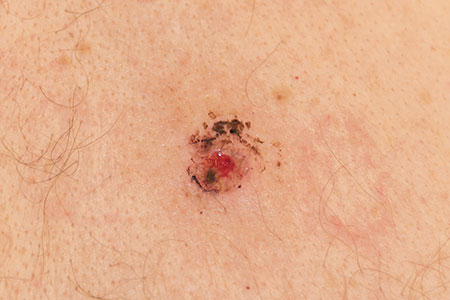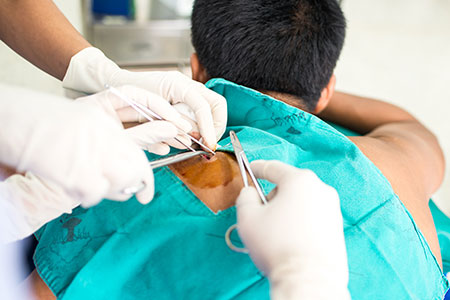Skin lesions are lumps or bumps such as moles, cysts, warts or skin tags. They can be removed from the skin using chemical and surgical procedures.
About skin lesion removal
Most skin lesions don’t cause serious problems, but you may want to have them removed for practical or cosmetic reasons.
Your dermatologist is able to advise you on what treatment will work for you.
Different methods of removal are used depending on what type of skin lesion you have. Some, such as benign (non-cancerous) warts, can be treated with non-surgical procedures. Larger skin lesions or ones that need a precise removal may need to be surgically removed.
Your dermatologist may advise you to have surgery if you have a skin lesion that shows any sign of turning cancerous (for example, a mole that has changed shape or colour). The removed tissue will be sent to a laboratory to examine the type of cells and determine whether the lesion is benign or cancerous.

Preparing for skin lesion removal
Skin lesion removal is usually done as an outpatient procedure. This means you have the procedure and go home the same day.
Skin lesion removal is usually done under local anaesthesia. This blocks pain from the area, but you may still be able to feel some movement. You will stay awake during the procedure.
Your dermatologist will discuss with you what will happen before, during and after your procedure, and any pain you might have. This is your opportunity to understand what will happen, and you can help yourself by preparing questions to ask about the risks, benefits and any alternatives to the procedure. This will help you to be informed, so you can give your consent for the procedure to go ahead, which you may be asked to do by signing a consent form.
It’s important to discuss the procedure with your dermatologist so that you know what to expect. For example, if your dermatologist surgically removes your skin lesion, he or she may need to remove some skin around the lesion, leaving a bigger wound than you may expect.
What happens during skin lesion removal?
The technique that your doctor uses to remove the lesion depends on factors such as its size and where it is on your body. Your doctor will advise which method is most appropriate for you.
- Some lesions can be shaved down to the level of your surrounding skin, either using a surgical blade, an electrical unit (electrocoagulation) or a laser (a high-energy beam of light) to destroy your skin tissue.
- Skin tags may be simply snipped off with surgical scissors.
- Other lesions, such as suspected skin cancer, can be cut out entirely and the wound closed with stitches.
- Warts may be frozen off with liquid nitrogen (this technique is called Cryotherapy).
Your doctor will apply a dressing to the wound if necessary but some wounds heal better if they are left uncovered.
What to expect afterwards?
You will be able to go home when you feel ready. If you have had a sedative, you will need to arrange for someone to drive you home.
If you have had a larger procedure, try to arrange for a friend or relative to stay with you for the first 24 hours.
Your doctor will give you some advice about caring for your healing wound before you go home.
Your wound may take one to two weeks to heal depending on whereabouts on your body it is and your age and general health.
Dissolvable stitches will disappear on their own in 7to 10 days. Non-dissolvable stitches are removed 8 to 16 days after surgery.
Your doctor may advise you to:
- Take painkillers such as paracetamol if you have any pain
- Avoid stretching the affected area, do not go swimming
- Take special care not to bump or knock the healing wound
- Keep the wound dry for 24 hours and clean it gently if the dressing becomes wet or dirty
- Try to avoid smoking until your stitches are removed because it delays healing
What are the risks?
Skin lesion removal is commonly performed and generally safe. However, in order to make an informed decision and give your consent, you need to be aware of the possible side-effects and the risk of complications of this procedure.
Side-effects
These are the unwanted, but mostly temporary effects of a successful treatment. You may have some pain, swelling, and bruising of the skin around the wound.
A skin wound will usually leave a scar. How big and noticeable this is depends on how much of your skin is removed. Ask your dermatologist about how much scarring to expect after your treatment. Most scars fade significantly over the first year.

Complications
This is when problems occur during or after the operation. Most people aren’t affected. The possible complications of any operation include an unexpected reaction to the anaesthetic, excessive bleeding or an infection.
After having a skin lesion removed, there’s a risk you may develop an infection. An infected wound can take longer to heal and may result in a more noticeable scar. Contact your dermatologist if your wound:
- Causes increased pain
- Looks red, inflamed or swollen
- Starts to weep liquid, pus or blood
- Begins to smell unpleasant
If your wound becomes infected, your dermatologist may prescribe antibiotics to treat the infection.
Other complications of having a skin lesion removed are uncommon but can include:
- Bleeding under your skin (haematoma) – this may need draining
- Changes in your skin sensation – this can happen if surface nerves are damaged, it’s usually temporary
- Wound breakdown after stitches are removed. It may happen when there is excessive tension at the site and / or if the wound develops infection.
- Suture reactions. Suture material may elicit redness and swelling at the wound site, as they are foreign to the body. This is an expected reaction and does not represent allergy or infection. Absorbable subcutaneous sutures may also occasionally extrude through the skin as they dissolve; this can occur weeks or months after the procedure. True allergy to suture material is rare but has been reported.
- Unusual red or raised scars (keloids) – these can be difficult to treat.
- Incomplete excision of a skin cancer. A margin of healthy appearing skin is excised around askin cancer to improve the chances of its complete removal. Once excised, the removed skin is sent to a pathologist for examination under a microscope. This gives a more reliable indication of whether the whole lesion has been removed. Skin cancers can occasionally recur even after careful surgery and when the pathologist has reported clear margins. If a skin cancer is not completely excised, further surgical treatment may be required.
- Non-cancerous skin lesions may also recur. For example, epidermalcysts that have been drained or excised may reappear, requiring further surgery.
- Damage to important structures. It may happen if the lesion has grown deep into underlying structures or is in a site where important structures such as nerves or salivary glands lie close to the skin surface.
The exact risks are specific to you and will differ for every person. Ask your dermatologist to explain how these risks apply to you.



